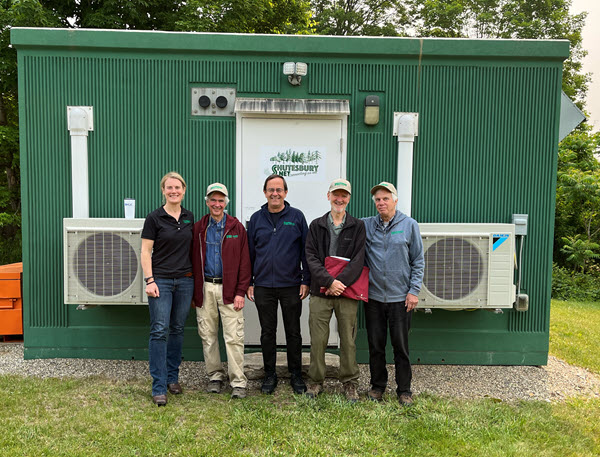The Shutesbury Broadband Committee was formed in early 2014 with the purpose of investigating and developing a sustainable operation for community-wide high-speed internet. The formal establishment of a committee followed from more than two decades of work by various ad hoc groups that arose in Shutesbury and Leverett. (For details of local activity from 1992, see Project History from the Committee's records archive.)
Initial action steps involved examining the Leverett model for municipal high-speed internet, looking into funding opportunities with Wired West (a municipal light plant co-op), and pursuing options with the Massachusetts Broadband Institute (MBI) for possible grant funding by the state for the "last mile buildout." The Committee's early work centered on outreach and information sessions, ascertaining the level of community interest, and developing material and FAQs for an active website presence. The Committee conducted a Pole Inventory, a physical boots-on-the-ground survey where 80 volunteers walked and drove all 40 miles of Shutesbury roads, collecting GPS locations and pole numbers for about 1500 utility poles, needed in order to submit applications to the utility companies for permission to hang Shutesbury fiber lines on their poles. Analysis of Pole Inventory data allowed an estimate of to-build costs and a comparison of three different plans for project completion — the Wired West Plan (Regional Cooperative Solution), the Matrix Plan (Public-Private Partnership), and the Shutesbury Independent Plan.
Because of the many public information sessions and their high participation rate, attendees at the 2015 Annual Town Meeting voted overwhelmingly to authorize borrowing of $1.7 million as the Town's share fiber network construction costs, the remainder to come from state and MBI grant funding through Wired West. By August 2015, over 52% of all Shutesbury households had signed up for service and had made a $49 deposit, clearly demonstrating project viability.
In late 2015, however, the state changed its policy and MBI cancelled their cooperative agreement with Wired West, agreeing to take on network construction themselves. In 2016, Shutesbury began working on the Town Readiness Profile required by MBI, but in early 2017 MBI dropped their plans to build municipal networks, and projects ground to a halt across the state. Under public pressure, Governor Baker removed the program from MBI and placed municipally-owned networks under administration of the Executive office of Housing and Economic Development (EOHED). Because of their earlier work, the Shutesbury Broadband Committee was well-prepared for immediate application to EOHED for grant funding and was one of the first towns to be approved — quickly submitting make-ready applications to National Grid, Verizon, and Eversource for licensing to use the utility pole infrastructure.
At a Special Town Meeting on March 28, 2017, a five-member Municipal Light Plant (MLP) Board was created for the official legal decision-making and operation of ShutesburyNET, our municipally-owned high speed internet provider. Westfield Gas and Electric was selected to design, engineer, and build the network in May, and by the end of the year, make-ready work was getting underway to prepare utility poles for installation of the fiber network.
The Shutesbury Broadband Network Design was presented at Annual Town Meeting on May 5, 2018. July saw the start of a town-wide evaluation of all houses that currently get their utility service underground to see if existing conduit could be used for broadband service. By late summer, the Board had sent out a bid for network construction, placed an order for the central-network service hut that would house electronics, and issued an RFP for the internet service provider (ISP) and operator who would run the network. The year ended with site work underway to prepare for installation of the electronics hut behind Town Hall.
January 2019 saw construction of network infrastructure (steel support cables, fiber optic cables) throughout town roadways. February saw installation of the electronics hut, and March saw installation of the mainline distribution network 50% completed (all 42 miles completed in June). In April, the percentage of Shutesbury households subscribing to broadband reached 87%, exceeding the Committee's goal of 75%. Underground and aerial installation continued throughout the summer and fall and all subscribed installations had been completed by the end of the year.
In 2019, the Board was restructured to three elected officials plus an MLP managerial position overseen by the elected officials. The MLP Manager position is on Town payroll, but all other expenses related to the position are paid from the MLP budget, a budget supported by MLP revenues and held in an Enterprise Fund account, totally separate from the Town's financial budget. The Enterprise Fund makes allotments to the Town each year to repay the long-term borrowing that was required in building the network. This model has proven elsewhere to be effective and sustainable over long-term network operations, both for leadership and to meet the needs of the community.
In its creation and throughout its operation, the MLP Board was advised and assisted by the Shutesbury Broadband Committee. With a fully functional fiber optic network in place town-wide, the Committee's work was done. The Shutesbury Select Board congratulated and formally disbanded the Committee at its 2/11/2025 meeting.
ShutesburyNET continues to be run by one part-time paid manager who is overseen by the three elected members of the MLP Board. For more detailed information of its creation (with photos of steps along the way) and to read Committee minutes, go to the ShutesburyNET page.

The Broadband Team: Gayle Huntress, Steve Schmidt, Craig Martin, Graeme Sephton, Jim Hemingway (Spring 2019)
